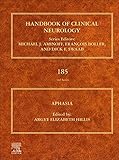Aphasia/ Volume 185 Handbook of Clinical Neurology
Material type: TextPublication details: Netherlands Elsevier 2022Edition: 3rd SeriesDescription: 336 pagesISBN:
TextPublication details: Netherlands Elsevier 2022Edition: 3rd SeriesDescription: 336 pagesISBN: - 9780128233849
- WL340.5
| Item type | Current library | Shelving location | Call number | Status | Date due | Barcode | Item holds | |
|---|---|---|---|---|---|---|---|---|
 General Book
General Book
|
Kuakarun Nursing Library | Processing unit | WL340.5 H362 2022 (Browse shelf(Opens below)) | Available | 0000047260 |
Handbook of Clinical Neurology 3rd Series --- History and conceptual models of language and the brain --- History of aphasia: A broad overview --- Early Mentions --- Case Descriptions --- Toward an Explanation --- Localization of Speech Production --- Localization of Language Comprehension --- Diagrams --- Grammatical Disorders --- Against Localization --- Assessment --- Rehabilitation --- Epilogue --- Broca-Wernicke theories: A historical perspective --- Learning From History --- The Era of Localization --- Precursors of Broca: Gall, Bouillaud --- Broca --- Wernicke --- Diagram Makers --- Against the Localistic Language Models --- Intraoperative Electric Stimulation Mapping --- The Lesion-Deficit Approach --- Revisited --- Functional Systems --- Neuroanatomy of speech and language --- Vascular syndromes: Revisiting classification of poststroke aphasia --- History of Localization and Classification: Contributions of Early Researchers --- Vascular Territories --- Vascular Syndromes --- Recovery and Transition Over Time --- The dual stream model of speech and language processing --- The Wernicke-Lichtheim-Geschwind Model --- Problems With the Classical Model --- The Dual-Stream Organization of the Brain --- Foundations of the Hickok-Poeppel Dual-Stream Model --- The Hickok-Poeppel Dual-Stream Model --- Taking Dual-Stream Parallels Seriously: Implications for the Study and Evolution of Language --- Homologous Neurocomputational Architectures for Dorsal Stream Speech and Nonspeech Motor Control --- The Model From the Perspective of Language Production and the Expressive-Receptive Asymmetry --- Situating Syntax in the Model --- Types of motor speech impairments associated with neurologic diseases --- A Detailed View of the Dysarthrias --- Special Considerations Based on Mechanism of Injury --- Assessment and Treatment Considerations --- Conclusions --- Clinical and neuroimaging characteristics of primary progressive aphasia --- Semantic Variant Primary Progressive Aphasia --- Nonfluent Primary Progressive Aphasia --- Logopenic Variant Primary Progressive Aphasia --- The role of disrupted functional connectivity in aphasia --- A Brief Connectivity Primer
Disrupted Functional Connectivity in Poststroke Aphasia (PSA) --- Disrupted Functional Connectivity in Primary Progressive Aphasia (PPA) --- Methodologic Considerations and Current Limitations --- Conclusions --- The role of disrupted structural connectivity in aphasia --- Contributions of Lesion Symptom Mapping
Caveats of Lesion Symptom Mapping --- Measuring Structural Connectivity --- Models of Language Processing Based on Brain Connections --- Key Regions and Connections Associated With Language Function --- Conclusions --- Language recovery --- Functional MRI evidence for reorganization of language networks after stroke --- fMRI in Neuroimaging Research --- fMRI in Poststroke Aphasia --- fMRI Evidence in Poststroke Treatment-Induced Language Recovery --- Conclusions --- The contribution of positron emission tomography to the study of aphasia --- FDG-PET --- Amyloid PET --- TAU-PET --- Neuroinflammation PET --- Conclusions --- Electrophysiologic evidence of reorganization in poststroke aphasia --- Electrophysiologic Methods --- Evidence From the Event-Related Potential --- Evidence From Spectral Power Differences --- Overall Summary --- Assessment of language impairment and function --- Purposes of Aphasia Assessment --- LANGUAGE Checklist for Aphasia Assessment --- Screening and Tracking Aphasia --- Language intervention --- Behavioral interventions for poststroke aphasia --- Behavioral Interventions for Poststroke Aphasia --- The ICF and Aphasia --- Linguistic Processes and Aphasia --- Intervention Planning in Aphasia --- Classifying Behavioral Interventions for Poststroke Aphasia --- Alternate Models of Service Delivery for Aphasia --- Conclusion --- Behavioral interventions for primary progressive aphasia --- Clinical Assessment in PPA --- Restitutive Interventions --- Compensatory Interventions --- Communication Partner Training --- Technology-Mediated Intervention --- Person-Centered Treatment --- Additional Considerations --- Noninvasive brain stimulation to augment language therapy for poststroke aphasia --- Noninvasive Brain Stimulation for Neurorehabilitation in PostStroke Aphasia --- Rationale for Administering NIBS to Treat PostStroke Aphasia --- Language Processes Shown to Improve Following NIBS --- Using NIBS to Enhance Outcomes of Behavioral Therapy
Current Limitations and Knowledge Gaps --- Concluding Remarks --- Noninvasive brain stimulation to augment language therapy for primary progressive aphasia --- Non-invasive Brain Stimulation --- Augmenting Language Therapy With Neuromodulation in Primary Progressive Aphasia --- Augmenting Untrained Tasks With Neuromodulation in Primary Progressive Aphasia --- Predicting Response to Treatment With Noninvasive Brain Stimulation --- Future Directions --- Better language through chemistry: Augmenting speech-language therapy with pharmacotherapy in the treatment of aphasia --- Catecholamines
Glutamate and GABA --- Acetylcholine --- Serotonin --- Final Thoughts --- Recent advances --- Ethical considerations in the management of poststroke aphasia --- Informed Consent: Competence and Decision-Making Capacity --- Establishing DMC --- Patient Autonomy and Quality of Life --- Conclusions --- Genetics in aphasia recovery --- Genetics of Aphasia Recovery --- Genetics of Stroke Recovery --- Conclusion --- Sign language aphasia --- American Sign Language --- Deaf Language --- Neurobiology of Sign Language --- Sign Language Aphasia --- Concluding Remarks
There are no comments on this title.

